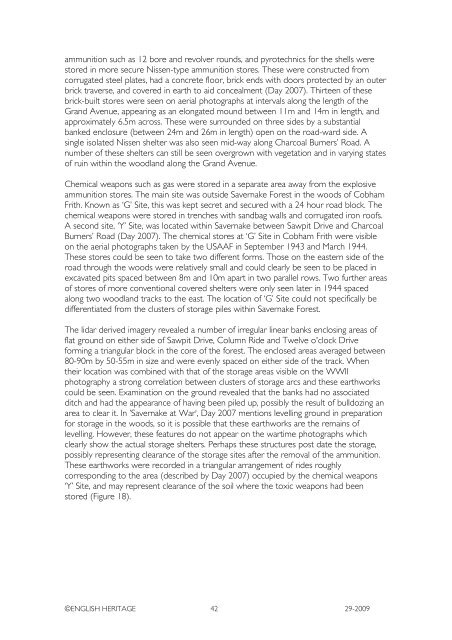savernake forest a report for the national mapping ... - English Heritage
savernake forest a report for the national mapping ... - English Heritage
savernake forest a report for the national mapping ... - English Heritage
You also want an ePaper? Increase the reach of your titles
YUMPU automatically turns print PDFs into web optimized ePapers that Google loves.
ammunition such as 12 bore and revolver rounds, and pyrotechnics <strong>for</strong> <strong>the</strong> shells were<br />
stored in more secure Nissen-type ammunition stores. These were constructed from<br />
corrugated steel plates, had a concrete floor, brick ends with doors protected by an outer<br />
brick traverse, and covered in earth to aid concealment (Day 2007). Thirteen of <strong>the</strong>se<br />
brick-built stores were seen on aerial photographs at intervals along <strong>the</strong> length of <strong>the</strong><br />
Grand Avenue, appearing as an elongated mound between 11m and 14m in length, and<br />
approximately 6.5m across. These were surrounded on three sides by a substantial<br />
banked enclosure (between 24m and 26m in length) open on <strong>the</strong> road-ward side. A<br />
single isolated Nissen shelter was also seen mid-way along Charcoal Burners’ Road. A<br />
number of <strong>the</strong>se shelters can still be seen overgrown with vegetation and in varying states<br />
of ruin within <strong>the</strong> woodland along <strong>the</strong> Grand Avenue.<br />
Chemical weapons such as gas were stored in a separate area away from <strong>the</strong> explosive<br />
ammunition stores. The main site was outside Savernake Forest in <strong>the</strong> woods of Cobham<br />
Frith. Known as ‘G’ Site, this was kept secret and secured with a 24 hour road block. The<br />
chemical weapons were stored in trenches with sandbag walls and corrugated iron roofs.<br />
A second site, ‘Y’ Site, was located within Savernake between Sawpit Drive and Charcoal<br />
Burners’ Road (Day 2007). The chemical stores at ‘G’ Site in Cobham Frith were visible<br />
on <strong>the</strong> aerial photographs taken by <strong>the</strong> USAAF in September 1943 and March 1944.<br />
These stores could be seen to take two different <strong>for</strong>ms. Those on <strong>the</strong> eastern side of <strong>the</strong><br />
road through <strong>the</strong> woods were relatively small and could clearly be seen to be placed in<br />
excavated pits spaced between 8m and 10m apart in two parallel rows. Two fur<strong>the</strong>r areas<br />
of stores of more conventional covered shelters were only seen later in 1944 spaced<br />
along two woodland tracks to <strong>the</strong> east. The location of ‘G’ Site could not specifically be<br />
differentiated from <strong>the</strong> clusters of storage piles within Savernake Forest.<br />
The lidar derived imagery revealed a number of irregular linear banks enclosing areas of<br />
flat ground on ei<strong>the</strong>r side of Sawpit Drive, Column Ride and Twelve o'clock Drive<br />
<strong>for</strong>ming a triangular block in <strong>the</strong> core of <strong>the</strong> <strong><strong>for</strong>est</strong>. The enclosed areas averaged between<br />
80-90m by 50-55m in size and were evenly spaced on ei<strong>the</strong>r side of <strong>the</strong> track. When<br />
<strong>the</strong>ir location was combined with that of <strong>the</strong> storage areas visible on <strong>the</strong> WWII<br />
photography a strong correlation between clusters of storage arcs and <strong>the</strong>se earthworks<br />
could be seen. Examination on <strong>the</strong> ground revealed that <strong>the</strong> banks had no associated<br />
ditch and had <strong>the</strong> appearance of having been piled up, possibly <strong>the</strong> result of bulldozing an<br />
area to clear it. In ’Savernake at War‘, Day 2007 mentions levelling ground in preparation<br />
<strong>for</strong> storage in <strong>the</strong> woods, so it is possible that <strong>the</strong>se earthworks are <strong>the</strong> remains of<br />
levelling. However, <strong>the</strong>se features do not appear on <strong>the</strong> wartime photographs which<br />
clearly show <strong>the</strong> actual storage shelters. Perhaps <strong>the</strong>se structures post date <strong>the</strong> storage,<br />
possibly representing clearance of <strong>the</strong> storage sites after <strong>the</strong> removal of <strong>the</strong> ammunition.<br />
These earthworks were recorded in a triangular arrangement of rides roughly<br />
corresponding to <strong>the</strong> area (described by Day 2007) occupied by <strong>the</strong> chemical weapons<br />
‘Y’ Site, and may represent clearance of <strong>the</strong> soil where <strong>the</strong> toxic weapons had been<br />
stored (Figure 18).<br />
©ENGLISH HERITAGE 42 29-2009

















